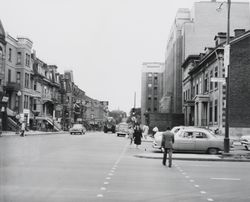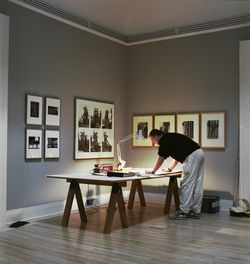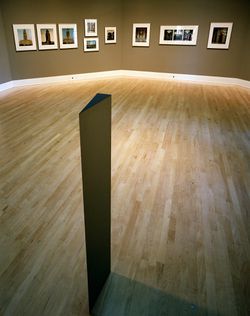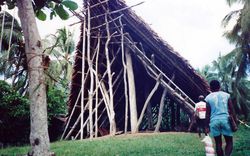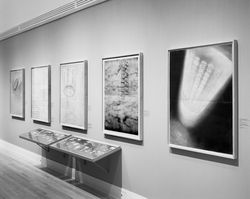Learning from... Montréal
Lance Blomgren uses his 2009 book Walkups—a novella set entirely within Montréal’s row house apartment buildings—as a springboard for an analysis of the discursive plane of fictional architecture. Looking at works by John Hejduk, Ilya Kabakov, Alice Aycock and others, Blomgren argues that contemporary modes of speculative architecture offer a vital, if ethically fraught,(...)
Paul-Desmarais Theatre
2 May 2013 , 7pm
Learning from... Montréal
Actions:
Description:
Lance Blomgren uses his 2009 book Walkups—a novella set entirely within Montréal’s row house apartment buildings—as a springboard for an analysis of the discursive plane of fictional architecture. Looking at works by John Hejduk, Ilya Kabakov, Alice Aycock and others, Blomgren argues that contemporary modes of speculative architecture offer a vital, if ethically fraught,(...)
Paul-Desmarais Theatre
Architecture and Its Image examines the complex relationships between drawings, photographs, prints, and other architectural representations and the buildings, landscapes, and cities they represent. The exhibition assembles images dating from the early sixteenth century to the late twentieth century from Tokyo and Rome to Mississauga and Montreal and includes maps, books,(...)
7 May 1989 to 7 August 1989
Architecture and Its Image
Actions:
Description:
Architecture and Its Image examines the complex relationships between drawings, photographs, prints, and other architectural representations and the buildings, landscapes, and cities they represent. The exhibition assembles images dating from the early sixteenth century to the late twentieth century from Tokyo and Rome to Mississauga and Montreal and includes maps, books,(...)
In this lecture, Amy Kulper locates architecture’s “digital turn” in 1988, when Thomas Knoll invented Photoshop. Originally developed as an image-editing software, Photoshop fit neatly within the long history of optical correction in the discipline. Yet its ubiquity today also prompts new questions. Does Photoshop simply introduce logics of adjustment, correction, and(...)
Paul Desmarais Theatre
9 June 2016, 6pm
Amy Kulper: Architecture’s Digital Turn and the Advent of Photoshop
Actions:
Description:
In this lecture, Amy Kulper locates architecture’s “digital turn” in 1988, when Thomas Knoll invented Photoshop. Originally developed as an image-editing software, Photoshop fit neatly within the long history of optical correction in the discipline. Yet its ubiquity today also prompts new questions. Does Photoshop simply introduce logics of adjustment, correction, and(...)
Paul Desmarais Theatre
Ben Bradley presents how the automobile shaped how Canadians encountered their country during the 20th century. As thousands and then millions came to know Canada by motoring, their travel patterns, viewing habits, and tastes shaped and reshaped the places they passed through. Canada’s roads came to be festooned with scenic pullouts, viewpoints, and a constellation of(...)
Paul Desmarais Theatre Keyword(s):
Canada, environment, Bradley, It's all happening so fast, roadside
23 February 2017, 6pm
Making Canada a Roadside Attraction
Actions:
Description:
Ben Bradley presents how the automobile shaped how Canadians encountered their country during the 20th century. As thousands and then millions came to know Canada by motoring, their travel patterns, viewing habits, and tastes shaped and reshaped the places they passed through. Canada’s roads came to be festooned with scenic pullouts, viewpoints, and a constellation of(...)
Paul Desmarais Theatre Keyword(s):
Canada, environment, Bradley, It's all happening so fast, roadside
*Cities of Artificial Excavation: The Work of Peter Eisenman, 1978–1988* explores how American architect and writer Peter Eisenman questioned the concept of “site,” and demonstrates the importance of drawing and modelmaking in generating his ideas. The exhibition reveals the richness and complexity of the design process by looking carefully at Eisenman’s drawings and(...)
Main galleries
2 March 1994 to 19 June 1994
Cities of Artificial Excavation: The Work of Peter Eisenman, 1978-1988
Actions:
Description:
*Cities of Artificial Excavation: The Work of Peter Eisenman, 1978–1988* explores how American architect and writer Peter Eisenman questioned the concept of “site,” and demonstrates the importance of drawing and modelmaking in generating his ideas. The exhibition reveals the richness and complexity of the design process by looking carefully at Eisenman’s drawings and(...)
Main galleries
Twenty-two colour photographs reveal Ernest Cormier’s central pavilion of the Université de Montréal as an integral part of the Montréal urban landscape and as a complex, varied spatial experience. The exhibition originated in a commission to Gabor Szilasi by the CCA when research into the Fonds Cormier revealed a major gap in the photographic documentation of the(...)
Octagonal gallery
2 May 1990 to 28 October 1990
Sighting the Université de Montréal: Photographs by Gabor Szilasi
Actions:
Description:
Twenty-two colour photographs reveal Ernest Cormier’s central pavilion of the Université de Montréal as an integral part of the Montréal urban landscape and as a complex, varied spatial experience. The exhibition originated in a commission to Gabor Szilasi by the CCA when research into the Fonds Cormier revealed a major gap in the photographic documentation of the(...)
Octagonal gallery
articles
The Sensory Interior
The rest of your senses
The exhibition explores one of the most adventurous and influential moments in the history of architecture: the explosion of invention and ideas that followed the October Revolution in Russia. The Soviet avant-garde architects were productivist as much as aesthetic in their concerns; they saw architecture and the arts as one, and they were committed to bringing design(...)
Main galleries
19 June 1991 to 8 September 1991
Architectural Drawings of the Russian Avant-Garde, 1917-1935
Actions:
Description:
The exhibition explores one of the most adventurous and influential moments in the history of architecture: the explosion of invention and ideas that followed the October Revolution in Russia. The Soviet avant-garde architects were productivist as much as aesthetic in their concerns; they saw architecture and the arts as one, and they were committed to bringing design(...)
Main galleries
textual records
AP075.S3.SS2.149
Description:
This box contains professional correspondence, organized in chronological order, from 1958-1993, with a bulk of documents dated from 1978-1993. This correspondence contains chiefly letters related to publishing in landscape architecture publications, correspondence with schools of architecture and landscape architects associations, such as the Canadian Society of Landscape Architects, about membership or attendance to events. It also comprises correspondence related to research on play and playgrounds, collaboration with organizations for children education, research and involvement in sustainable development. It also contains correspondence with city planning committees or other governmental institutions related to projects or consultation in landscape design, and letters of reference or offer of services. This correspondence also comprises a few letters related to Oberlander's projects such as Children's Creative Centre Playground at Expo '67 in Montréal, University of British Columbia Faculty Club additions (which includes correspondence with Arthur Erickson), the Museum of Anthropology. It includes mainly letters of congratulations or comments for her design.
1958-1993
Professional correspondence from 1958-1993
Actions:
AP075.S3.SS2.149
Description:
This box contains professional correspondence, organized in chronological order, from 1958-1993, with a bulk of documents dated from 1978-1993. This correspondence contains chiefly letters related to publishing in landscape architecture publications, correspondence with schools of architecture and landscape architects associations, such as the Canadian Society of Landscape Architects, about membership or attendance to events. It also comprises correspondence related to research on play and playgrounds, collaboration with organizations for children education, research and involvement in sustainable development. It also contains correspondence with city planning committees or other governmental institutions related to projects or consultation in landscape design, and letters of reference or offer of services. This correspondence also comprises a few letters related to Oberlander's projects such as Children's Creative Centre Playground at Expo '67 in Montréal, University of British Columbia Faculty Club additions (which includes correspondence with Arthur Erickson), the Museum of Anthropology. It includes mainly letters of congratulations or comments for her design.
textual records
1958-1993
Inside the Sponge
Simmons Hall is an award-winning university dormitory designed by architect Steven Holl on the Massachusetts Institute of Technology (MIT) campus in Cambridge. Inspired by the sea sponge and the concept of porosity, the building is radical in structure and ambitious in its program to encourage social interaction. Inside the Sponge is an investigation of Simmons Hall from(...)
Octagonal gallery
10 August 2006 to 19 November 2006
Inside the Sponge
Actions:
Description:
Simmons Hall is an award-winning university dormitory designed by architect Steven Holl on the Massachusetts Institute of Technology (MIT) campus in Cambridge. Inspired by the sea sponge and the concept of porosity, the building is radical in structure and ambitious in its program to encourage social interaction. Inside the Sponge is an investigation of Simmons Hall from(...)
Octagonal gallery
